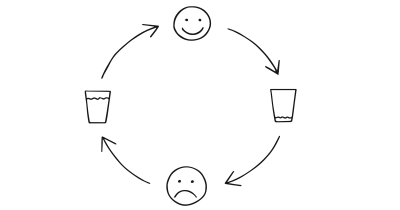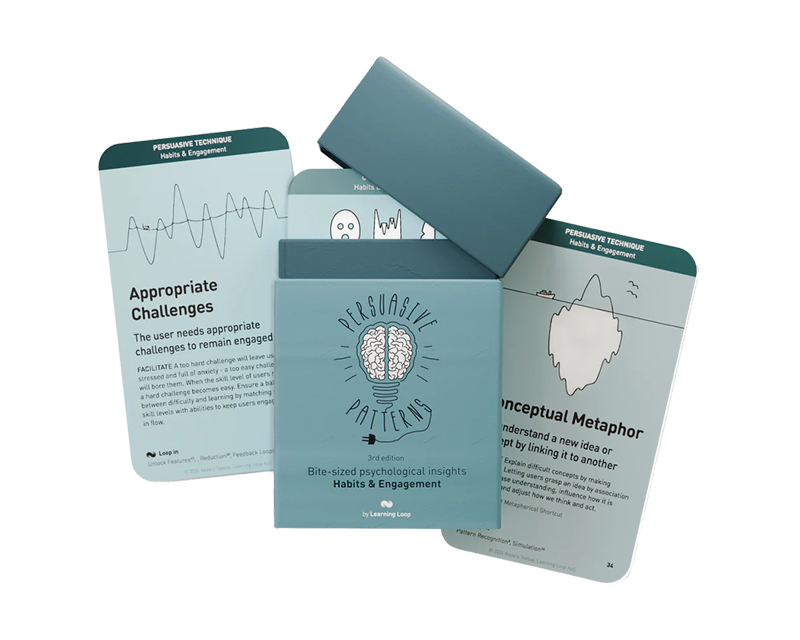Persuasive Patterns: Temptation
Temptation Bundling
Engaging in hard tasks is more likely when coupled with something tempting

Temptation bundling is a strategy where a desired activity is paired with a less desirable one to increase engagement with the latter. This technique leverages the appeal of the preferred task to motivate completion of the necessary but unappealing one.
Imagine you dislike cleaning your house, but you love listening to music. Temptation Bundling can come to the rescue! You decide that you’ll only allow yourself to listen to your favorite music playlist while you clean. This way, the chore becomes more enjoyable, and you’re more likely to complete it.
This strategy highlights the core principle of Temptation Bundling: combining a less desirable activity with a more enjoyable one to increase motivation. Let’s see how this translates to the digital world.
Building on the cleaning and music analogy, many fitness apps leverage Temptation Bundling. Imagine an app that allows you to listen to audiobooks or podcasts only while you’re running or working out. This way, the app transforms a potentially monotonous activity (running) into a more engaging experience (listening to an audiobook). Research suggests that such strategies can significantly increase exercise adherence.
Similar to the music and cleaning example, the fitness app creates a bundle where the less desirable activity (exercise) is made more appealing by the temptation (listening to an audiobook). This demonstrates how Temptation Bundling can be a powerful tool for digital products to influence user behavior in a positive way.
The study: Holding the Hunger Games hostage
One of the foundational studies that effectively demonstrates the power of temptation bundling comes from research conducted by Katherine Milkman at the University of Pennsylvania. Milkman et al. examined how coupling wants (listening to captivating audiobooks) with shoulds (exercising at the gym) affected gym attendance. The study provided participants with iPods loaded with audiobooks that they could find engaging (e.g., “The Hunger Games”), but these iPods were only available to them at the gym. The findings were compelling: gym attendance increased significantly among participants whose audiobook listening was restricted solely to the gym, demonstrating how a desirable activity can incentivize engagement in a less appealing one.
Milkman, K. L., Minson, J. A., & Volpp, K. G. (2014). Holding the Hunger Games hostage at the gym: An evaluation of temptation bundling. Management Science, 60(2), 283-299.
Temptation bundling operates on the principle that the allure of a pleasurable activity can offset the aversion to a less enjoyable task, facilitating the simultaneous execution of both. The primary goal of this approach is to enhance productivity and adherence to necessary but mundane routines by linking them with more enjoyable experiences. This can lead to improved habit formation, increased task completion, and overall better engagement with both activities. For instance, listening to a favorite podcast only while exercising can make the workout more appealing and ensure consistency in physical activity.
Temptation bundling is primarily based on the psychological principle of reinforcement, which plays a critical role in shaping behavior. This principle suggests that behaviors followed by favorable outcomes are more likely to be repeated, and behaviors followed by unfavorable outcomes are less likely to be repeated. In the context of temptation bundling, the favorable outcome is the enjoyment or pleasure derived from the tempting activity, which reinforces the completion of a less desirable task.
By bundling a desired activity (the temptation) with a less desirable one (the “should do”), Temptation Bundling creates a scenario where engaging in the less preferred task becomes a prerequisite for accessing the reward (the temptation). This psychological association increases the overall appeal of the combined activity, making the less desirable task feel less like a chore and more like a stepping stone to the desired reward.
Due to Hedonic Adaptation, we tend to quickly return to a relatively stable level of happiness despite major positive or negative events or life changes. By coupling tasks people do not desire with those that provide immediate gratification, temptation bundling helps maintain engagement by continuously renewing interest and satisfaction.
According to the principle of Commitment & Consistency, once we commit to something, we are more likely to go through with it. Temptation bundling leverages this by having individuals commit to a bundle of activities, thereby increasing the likelihood of completing the less desirable ones.
According to the Goal-Gradient Effect, the closer we get to a reward, the more motivated we are to achieve it. In temptation bundling, the immediate reward of the tempting activity motivates individuals to work through the less enjoyable task, effectively using the proximity to pleasure to enhance task completion.
All these theoretical concepts together explain why temptation bundling can be an effective strategy in both personal habit formation and broader behavior change initiatives. By aligning an immediate reward with the completion of a necessary task, this pattern not only enhances the likelihood of task completion but also improves overall engagement with the task, making it a powerful tool in behavioral psychology.
Designing products with Temptation Bundling
This technique cleverly pairs less desirable tasks with rewarding experiences, motivating users to complete both with greater enthusiasm.
Start by identifying the tasks that could benefit from temptation bundling. These might include mundane but necessary activities such as data entry, learning new skills, or adhering to a fitness regimen. Your next step is to find ways to seamlessly integrate these tasks with enjoyable or rewarding activities, which can significantly change the user’s attitude toward completing them. For example, in a corporate setting, an employee required to manage mundane tasks might receive free coffee or other perks, directly linking the completion of these tasks with a pleasurable reward.
The integration of rewarding experiences should be done in such a way that the reward is directly linked to the completion of the necessary task. This linkage ensures that the reward acts as a positive reinforcement, directly following the less desirable task. For instance, access to exclusive content or features in an app could be conditioned on completing specific milestones.
In terms of rewards, they should be immediately accessible upon task completion to reinforce the connection between the task and the pleasure derived from the reward. Varying the type of rewards or making them progressively more enticing can help maintain user interest and engagement over time.
Ensuring that the rewards themselves are genuinely desirable from the user’s perspective is critical. You need something to tempt with before you can bundle it with something more mundane. This requires an understanding of the user base and may involve collecting user feedback to continuously adapt and tailor the rewards to meet changing preferences and expectations.
Your Temptation Bundling checklist:
- Start by clearly defining what behaviors you are trying to encourage and how they align with user goals. This clarity will help determine which patterns will most effectively complement temptation bundling.
- Ensure that the integration of patterns feels natural and seamless. For example, if combining commitment and consistency with temptation bundling, the commitment process should be simple and the rewards for consistency immediately gratifying.
- Use feedback loops not just as a pattern to pair with but as a method for refining the integration of multiple patterns. Monitor how users respond to the combination of temptation bundling with other strategies and be prepared to make adjustments based on user behavior and feedback.
- Tailor rewards to fit the specific preferences and interests of the target audience. This customization increases the perceived value of the rewards, making the temptation bundling more effective.
- Always consider the overall user experience when integrating multiple behavioral patterns. The goal is to enhance, not complicate, the user journey. For instance, when using the endowed progress effect, make sure that the initial ‘progress’ is perceived as a meaningful head start rather than a trivial gesture.
Ethical recommendations
Temptation bundling, while effective in promoting certain behaviors, carries the potential for misuse, especially when not aligned with the best interests of users.
The main risk lies in manipulating user behavior in ways that prioritize business objectives over user welfare. For instance, if temptation bundling is used to encourage excessive consumption or addictive behaviors, it can lead to negative outcomes for users, such as financial distress or health issues. Additionally, there is a risk of undermining genuine motivation if users come to rely solely on external rewards rather than internal motivation, potentially leading to a long-term decrease in engagement once rewards are no longer appealing or are withdrawn.
Unethical malpractice include:
- Deceptive bundling
Hiding the less desirable task or making it unclear what users need to do to access the temptation is deceptive. This undermines trust and can damage the user experience. - Exploiting user vulnerabilities
Temptation Bundling shouldn’t exploit vulnerabilities like fear of missing out (Scarcity Bias) or urgency to pressure users into completing unnecessary tasks. - Excessive rewards
Overly extravagant rewards for mundane tasks can create unrealistic expectations and distort user behavior. Focus on rewards that genuinely enhance the user experience. - Inaccessible rewards
Making the temptation unreasonably difficult to access after completing the task creates frustration and breaks the trust established through the bundling approach.
To ensure that temptation bundling is used ethically and remains user-centric, several best practices should be adopted:
- Be transparent
Be upfront about both the desired task and the reward offered. Users appreciate clear communication and are more likely to engage authentically. - Focus on providing user value
Design temptation bundling strategies that genuinely align with the user’s long-term goals and interests. For example, if a health app uses temptation bundling to encourage exercise, the rewards should support a healthy lifestyle rather than contradict it. Don’t prioritize manipulation over genuine user benefit. - Keep rewards proportionate
Ensure that the rewards offered are proportionate to the effort required. Overly generous rewards may encourage unhealthy behavior patterns, while insufficient rewards might lead to frustration and disengagement. - Respect user choice
Temptation Bundling should guide, not coerce. Users should always feel empowered to choose whether to engage with the bundled activity. - Prioritize the user’s experience
The ultimate goal is to create a positive and motivating experience. Use Temptation Bundling strategically to enhance the value proposition for users.
Real life Temptation Bundling examples
Audible's Fitness
Challenge: Audible partnered with fitness experts to create workout playlists and routines available exclusively through their app. Users could unlock these audiobooks and playlists by maintaining a regular exercise schedule, effectively bundling the task of exercising with the reward of enjoyable content.
Google's Travel Expense Policy
Google offers a unique approach in its travel policies where employees can opt to stay in budget accommodations or choose cheaper travel options. The money saved is then allocated to the employee’s departmental budget for team activities, essentially rewarding teams for frugal spending with more discretionary funds.
Nike Run Club App
Nike’s Run Club app incentivizes runners to keep using the app through various challenges and achievements that unlock exclusive content and personal coaching tips. This encourages continued engagement by coupling running – often seen as a chore — with personalized rewards and social recognition.
Trigger Questions
- What tasks within our product could benefit from bundling?
- What activities do our users find inherently enjoyable?
- Can we personalize the temptation based on user data?
- How can we ensure the temptation is clearly linked to task completion?
- Are we being transparent about the bundling strategy?
- Have we considered the long-term impact of using Temptation Bundling?
- Are we making the process of receiving rewards simple and enjoyable, or could it be perceived as another hurdle?
- How can we ensure that the introduction of rewards does not overshadow the importance of the task itself?
Pairings
Temptation Bundling +
Commitment and Consistency
When users commit to a bundle, the principle of consistency can motivate them to follow through with the commitment. For example, a fitness app could ask users to set a monthly goal and then tempt them with custom music playlists only accessible upon goal completion.

Engaging in hard tasks is more likely when coupled with something tempting
Temptation Bundling + Endowed Progress Effect
This involves giving users a head start in a process, which can be combined with temptation bundling to increase engagement. For instance, a loyalty program might start users off with bonus points and offer additional points when they make healthy choices, such as purchasing salads instead of fries.

Engaging in hard tasks is more likely when coupled with something tempting

Early help speeds up goal achievement
Temptation Bundling + Feedback Loops
Providing users with immediate feedback on their actions enhances the effectiveness of temptation bundling. In an educational app, this could look like immediate access to fun, educational games after a study session to reinforce learning and encourage continued use.

Engaging in hard tasks is more likely when coupled with something tempting

We are influenced by information that provides clarity on our actions
Temptation Bundling + Goal-Gradient Effect
The closer users get to achieving a goal, the more motivated they are. When paired with temptation bundling, users could unlock more valuable rewards as they progress, enhancing engagement. A sales performance tool might unlock more prestigious rewards as team members hit higher sales thresholds.

Engaging in hard tasks is more likely when coupled with something tempting

Our motivation increases as we move closer to a goal
Temptation Bundling + Rewards + Privileges
Directly rewarding users for completing tasks can make temptation bundling more compelling. An example is a corporate wellness program where employees earn points for gym visits that can be exchanged for free health screenings or spa days.

Engaging in hard tasks is more likely when coupled with something tempting

Use rewards to encourage continuation of wanted behavior

Give users a way to reach their goal more quickly than they could before
Temptation Bundling + Scarcity Bias + Framing Effect
An e-commerce platform could offer early access to a scarce and limited-edition product only after users complete a product review. The product description could be framed positively to highlight the exclusivity and value of the limited-edition item. This approach creates a sense of urgency and motivates users to complete reviews to access the desired product.

Engaging in hard tasks is more likely when coupled with something tempting

We value something more when it is in short supply

The way a fact is presented greatly alters our judgment and decisions
Temptation Bundling + Loss Aversion
A financial planning app could allow users to unlock investment tips (temptation) only after completing a risk assessment quiz. This taps into Loss Aversion – users are motivated to complete the quiz to avoid missing out on potentially valuable investment information.

Engaging in hard tasks is more likely when coupled with something tempting

Our fear of losing motivates us more than the prospect of gaining
A brainstorming tool packed with tactics from psychology that will help you build lasting habits, facilitate behavioral commitment, build lasting habits, and understand the human mind. It is presented in a manner easily referenced and used as a brainstorming tool.
Get your deck!- Holding the Hunger Games Hostage at the Gym [ by Milkman, Minson & Volpp
- Teaching temptation bundling to boost exercise [ by Kirgios, et. al.
- Temptation Coupling
- When Willpower Isnt Enough at Freakonomics
- Khushaba, S., Kim, A. J., & Choo, H. J. (2017). Using Habit Stacking to Improve Task Management in Mobile Devices. Proceedings of the 19th ACM Conference on Computer-Supported Cooperative Work and Social Computing, 689-699.
- Milkman, K. E., Lurey, M. L., & Bryan, A. D. (2016). Building change into routine: The psychology and economics of habit formation. Journal of Economic Perspectives, 30(3), 132-163.
- Milkman, K. L., Minson, J. A., & Volpp, K. G. (2014). Holding the Hunger Games hostage at the gym: An evaluation of temptation bundling. Management Science, 60(2), 283-299.
- Milkman, K. L., Rogers, T., & Bazerman, M. H. (2008). Harnessing our inner angels and demons: What we have learned about want/should conflicts and how that knowledge can help us reduce short-termism in American society. Policy Insights from the Behavioral and Brain Sciences, 1(1), 209-215.
- Duckworth, A. L., Milkman, K. L., & Laibson, D. (2018). Beyond willpower: Strategies for reducing failures of self-control. Psychological Science in the Public Interest, 19(3), 102-129.
- Duckworth, A., Gendler, T. S., & Gross, J. J. (2016). Situational strategies for self-control. Perspectives on Psychological Science, 11(1), 35-55.
- Ariely, D., & Wertenbroch, K. (2002). Procrastination, deadlines, and performance: Self-control by precommitment. Psychological Science, 13(3), 219-224.
- Premack, D. (1965). Reinforcement theory. In W. K. Honig (Ed.), Operant behavior (pp. 123-163). Appleton-Century-Crofts.
- Skinner, B. F. (1953). Science and human behavior. Macmillan.
- Thaler, R. H., & Sunstein, C. R. (2008). Nudge: Improving decisions about health, wealth, and happiness. Yale University Press.
- Fogg, B. J. (2009). A behavior model for persuasive design. Proceedings of the 4th International Conference on Persuasive Technology, 1-7.
